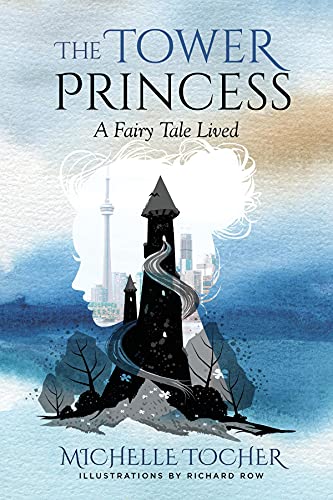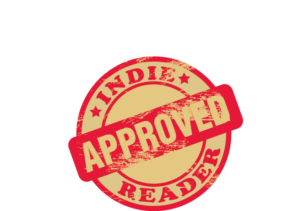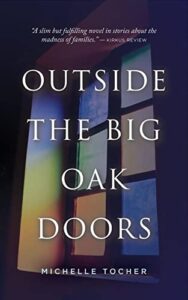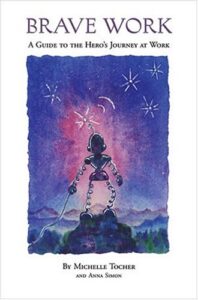The Tower Princess: A Fairy Tale Lived received a 4+ star review, making it an IndieReader Approved title.
Following find an interview with author Michelle Tocher.
What is the name of the book and when was it published?
The book is The Tower Princess: A Fairy Tale Lived, and it was published May 31, 2021
What’s the book’s first line?
“I can’t imagine a world without fairy tales.”
What’s the book about? Give us the “pitch”.
The Tower Princess tells the story of what happened when I turned to fairy tales as a source of hope. I was struggling with chronic pain and depression and had just been told by doctors that I might be living with pain for the rest of my life. I wasn’t sure that I could do it, and I was desperate to find the strength to meet a very unexpected fate. As a storyteller, I knew that fairy tales had the power to reflect our predicaments and guide us through descent journeys. I didn’t know exactly how to get into the depths of a story. I didn’t want to analyze the fairy tales, I wanted to contact them, be touched and transformed by them, so I started down a path into that otherworld. I decided to journal my experience and report on my experience, inside and out.
What inspired you to write the book? A particular person? An event?
I had been reading the stories of princesses in particular. For the most part, they weren’t these self-indulged weaklings that our culture portrays them to be. They also weren’t these fierce, vengeful warrior princesses that we sometimes want them to be. They grieved, they wept, they mourned. They had the power of tears – tears that heal the blind, that become pearls. I felt that we had lost the princess archetype in the world. One day I went looking through my symbol dictionaries, and I couldn’t find a single entry for ‘princess.’
In fairy tales, there are lots of stories about kings who exile their daughters, and that’s what I felt we had done with the archetype of the princess. We had dismissed her, we had demeaned her. To me, she was the heart of the world. And then one day I had a vision of her. She had fallen to the ground under the weight of her heart. She could no longer carry her burden of sorrow. I felt that I had seen something very important about the state of the world. The princess has fallen. Has this world, driven by industry and machines, become uninhabitable for the heart?
What’s the main reason someone should really read this book?
It would be my hope that the book would find its way to people who are looking for some kind of story about what happens when you meet your pain with love. That was the ‘thread of the path’ for me. I was resolved to find a way to live within my suffering body, my ‘prison of bones,’ with the kind of joy that I saw in Rapunzel when she sang from her prison tower. That’s what riveted me. How do we find that power of love? The fairies did not fail me, and I truly believe that the way to the future will be made by people who have the courage to love in the face of terror, pain, and injustice. That’s where real magic lies. That’s where transformation happens.
What’s the most distinctive thing about the main character? Who-real or fictional-would you say the character reminds you of?
If you don’t mind, I’ll answer that question because although my book a non fiction memoir, it’s an interaction with imagined characters, not the least among whom are a troupe of disenfranchised fairy godmothers who have lost their connection with humanity. One of the most outspoken characters is a clumsy, overly dramatic godmother named Lucy Lightfeatherwaite. Lucy is well-intentioned, but she is “too brilliant” (in her own words) and often gets lost in her starry-eyed notions. She doesn’t have any regard for mortal limitations. To me, she was unleashed genius, the kind of driver who will get you to stardom but will not understand (or care about) the costs. Those are dangerous impulses.
When did you first decide to become an author?
I spent a summer in France with my parents when I was fourteen. I started writing poetry that year. I remember sitting on a beach with all these beautiful people around me, but I was mostly taken by an older woman who sat reflectively, looking at the water. I wondered what she was thinking, and I suddenly understood that there is way more to every person than what we see on the surface. I wrote one of my first poems about her. It was a very bad poem, but it expressed my wish to reach inside.
I don’t remember ever thinking “I want to be an author.” I have been writing all my life, constantly learning new forms. Publishing in the mainstream has been almost impossible for me, though, because my books don’t fit existing categories. I move between fact and fiction, fantasy and reality, to get beneath the surface, into the place where we can all recognize ourselves as human.
Is this the first book you’ve written?
No, the first book I wrote has not yet been published. It’s a novel, narrated by young woman who grows up among brothers. I found the manuscript in the basement a year or so ago and I read it again. I had forgotten how it ended, and I enjoyed the read! It’s called Outside the Big Oak Doors, and I expect it will be my next indie publication.
What do you do for work when you’re not writing?
I tell stories. I hold storytelling workshops to take people into the fairy tales and see their own reflections using their own imaginations. I’m the creator of a website called wonderlit.com. I am also creating an audio production of a play I wrote a few years ago. I guess I’m never not writing in some form!
How much time do you generally spend on your writing?
Every morning I write or read books and materials that are feeding the ideas I’m having. In the afternoon, I do all my other related work. I also sing and compose, and I love to walk into the forest whenever I can. A lot of writing gets done when you’re not writing, when the ideas are just cooking on a back burner. But as every cook knows, you can’t get too far away from the pot, or your dinner will be ruined! Writing is a way of life for me, really, I guess that’s what I’m saying.
What’s the best and the hardest part of being an indie?
The solitary path. You have to believe in yourself. I get all tongue-tied when people ask me, “Are you published? With whom? How many books have you sold?” Every single book is an act of love to write, and an act of courage to move into the world. I don’t have an agent, and I’ve only had a mainstream publisher for one of my books. (How to Ride a Dragon). There was an editor at that publishing company who really championed my book, Brave Work, which is all about following the call of your heart in your work. The trouble was, after she read the book, she quit her job at the publisher. It lost its champion, and I was left to bring it out into the world on my own!
The hardest thing for me as an indie writer is that you encounter many people who believe you’re not a ‘real’ writer if you don’t have a publisher. The best thing about being an indie writer is that you can dream up your own books. You can learn everything about publishing for yourself. You can steer your own course. There are so many more resources available now for indie publishers than there were ten years ago, from editing to publicity. For me, it’s fresh air. I can write between categories and take risks that publishers can’t take, plus I don’t have to stay trapped in the place of waiting for a publisher to accept or reject my submission. I have found that very hard, personally. It’s like waiting for the person you’re dating to call. Ugh!
Is there something in particular that motivates you (fame? fortune?)
Honestly all I really want to do is write a good story. I remember somebody asking the question, “What is a story worth telling?” For me, a story worth telling is one that tackles the hard question of how we write a credible happy ending. As Lucy asks in The Tower Princess, “Have we lost our endings?” I believe artists are desperately needed these days to help us to credibly imagine paths to reconciliation, restoration, and hope. I’m at an age, and we’re in a time when we’ve got cut to the chase and create art that seeks to have a lasting impact on people’s lives, aspirations, and imaginations.



